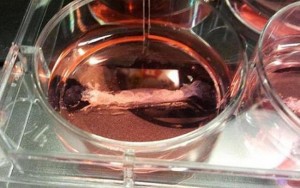Sunday Times 2
Would you eat dodo nuggets or in-vitro oysters?
Almost a year ago today the world’s first lab-grown burger was unveiled and eaten, albeit at the mouth-watering price of £250,000 ($420,000).
But in anticipation of a future where lab-grown meat is the norm, Dutch-based scientists, chefs and artists have launched a tongue-in-cheek cookbook for artificial food.

This picture, released by the University of Maastricht in the Netherlands on August 5, 2013, shows a sample of lab-grown meat in a petri dish (AFP)
The bizarre assortment of test-tube dishes includes roast raptor leg, dodo nuggets and in-vitro oysters.
The In Vitro Meat Cookbook was unveiled in Amsterdam a year after scientists revealed the world’s first lab-grown beef burger in London, in what is hoped to spark a global food revolution.
The 186-page cookbook will cost £19 ($32) and is based on the idea that meat can be ‘grown’ in a bioreactor from cells taken from live animals.
It is packed with new suggestions on what future cultivated meat products could look like.
‘This cookbook aims to move beyond in vitro meat as an inferior fake-meat replacement, to explore its creative prospects and visualise what in vitro meat products might be on our plate one day,’ says scientist and philosopher Dr Koert van Mensvoort, one of the book’s main contributors.
All recipes were created by a team of chefs, designers and artists, said Dr van Mensvoort in its preface, adding: ‘While some dishes are innovative and delicious, others are uncanny and macabre.’
The book also explains how to cultivate home-grown meat in a lab kit, before harvesting it for the pot.
For instance, on page 63 there’s ‘Roast Raptor’, which uses chicken tissue to grow meat around ‘dinosaur bones’ made in a 3D printer to create anatomically accurate models of dinosaur parts.
‘Let the dinosaur rest for 15 minutes before carving and serving,’ it suggests after cooking.
In another recipe, tissue engineering and advanced genetic sequencing from a dodo sample preserved by the Oxford University Museum of Natural History will allow history aficionados to ‘sample what the first sailors to visit Mauritius did in 1598.’
There are decidedly less appetising ideas too, for instance oysters grown from meat stem cells.
‘Bathed in a warm sea of serum, row upon row of miniature bioreactors nurture small morsels of flesh,’ is how the cookbook describes the test-tube oyster farm.
‘Connoisseurs may become adept at picking out the terroir of each lab, from the briny metal overtones of Atlantic serum to the sweeter, more rounded flavour from Pacific facilities,’ the book said.
Last year Professor Mark Post of Maastricht University in southern Netherlands unveiled the so-called ‘Frankenburger’ in London, showing that cultured beef using strands of meat grown from muscle cells was indeed possible.
Scientists insist artificial beef is safe, claiming it could eventually replace ordinary beef in the diets of millions of people and in so doing reduce huge environmental pressure caused by raising livestock.
‘Our aim is not to promote lab-grown meat, nor to predict the future, but to visualise a wide range of possible new dishes and food cultures to help us decide what future we actually want,’ Van Mensvoort said.
© Daily Mail, London

